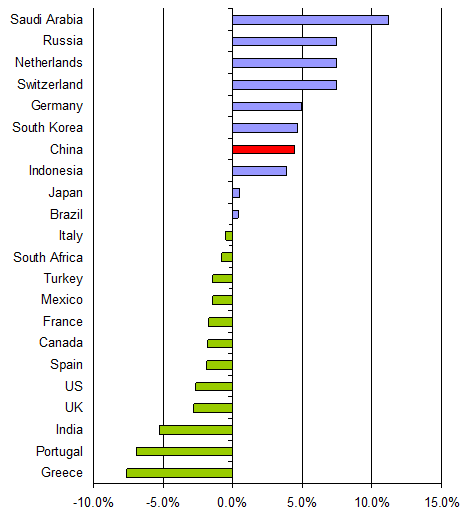Criticism of China’s exchange-rate policy continues throughout the US. This column argues that the US is in fact the exchange rate manipulator, due to its ongoing quantitative easing. What the US needs to do for a sustainable turnaround is to learn from other successful economies like China and Germany – not de-rail them.
One way to expose the economic mumbo-jumbo that is applied to the Chinese exchange rate by otherwise respectable economists is to look at it from the perspective of Germany and international trade.
China bashers – who, from stuttering economies, lecture those who have presided over the biggest economic miracle that has occurred without thieving foreign lands or labour – like to focus on current-account imbalances.
A better measure of competitiveness would be the trade account.
- The current account includes “hot money” inflows that come under the exchange control restrictions and have ballooned since the China bashers created the belief that the renminbi is a one-way appreciation bet.
- China’s annual trade surplus with the world was $184.5 billion at the end of 2010 or 3.6% of GDP.
- More than 10 significant economies have a larger trade surplus as a share of GDP than China (see Figure 1).
- Natural-resource-poor Germany is the most interesting analogy and it has the largest 12-month trade surplus in dollar terms in the world at $205.4 billion or 6.0% of GDP.
If you listen to the discourse in the US, you would believe that a country cannot run a trade surplus unless it manipulates its exchange rate.
Figure 1. Trade balances, % of GDP, 2009

The German example
This is false in general, and Germany certainly cannot be accused of manipulating its exchange rate in its “favour”.
- Its exchange rate with non-Eurozone members – around 50% of its trade – is floating and from the low of 2002 has appreciated by 60% versus the dollar.
- Its exchange rate with other Eurozone members is fixed at a rate set in 1999.
At the time it was considered an onerous rate for Germany given unification at 1:1 between the ostmark and deutschemark and the devaluations of many European countries from their pegs in the 1990s. (A similar story could be said of China’s 1994-2005 dollar peg from which the currency is now appreciating. Measured by actual, private, hot money outflows, the same peg that is now considered undervalued, was considered overvalued and vulnerable to devaluation.)
Is Germany’s trade surplus a result of artificially depressed consumption? It is hard to make this case when Germany has the lowest unemployment rate of G7 countries. At 6.6% on a standardised measure, its unemployment rate is below almost all estimates of Germany’s “natural rate of unemployment” due to geographical and skill mismatches and other frictions, suggesting internal demand is bordering on the too high, not too low. Indeed, GDP growth per head over the past 10 years is higher than any other G7 country, including Canada and the US.
Scrooge does not holiday in Spain, drive a Mercedes, and live in Dusseldorf.
Is export-led growth sustainable?
A further argument used against Germany’s economic success is that this export-led growth is not sustainable.
- But two-thirds of Germany’s export growth has been driven by emerging economies that are growing considerably faster than Germany or the G7.
If they continue to choose to build their economic expansions by importing quality German engineering products, then Germany can sustain economic out-performance of G7.
- Germany is in the position it is in as a result of the difficult reforms carried out earlier and the abstinence from mortgage orgies that allowed Germany to keep private debt levels down and to channel investment into improving product-quality.
The same countries that indulged in excessive lending to domestic consumers to buy each other’s house and to governments to fund ill-advised foreign wars, presume to lecture those who did not, claiming that it is all about the nominal exchange rate.
The old unfair trade excuses
Unfair exchange rate manipulation against US manufacturers is a perennial cry. Detroit has been at it long before China’s rise. Twenty years ago we were told that a critical reason why consumers bought Toyota and Nissan was unfair trade practices, not because they did not want shoddily-put-together gas guzzlers. The dollar’s unsteady devaluation has not stopped the relative decline of Detroit globally or even in the US, but it has caused costly if temporary disruption. It contributed to Japan’s long depression and the 1992-1995 European Monetary System crisis – both of which were triggered by record lows for the dollar, not in the crisis countries.
Today, dollar weakness, fuelled by quantitative easing, is leading to a global rise in inflation. The exchange rate manipulator is the US. It is far easier to manipulate a floating currency lower than to manipulate a fixed-exchange rate. Dollar devaluation is the policy, and understandably so from a US perspective given the limits to monetary and fiscal policy.
But what the US needs to do for a sustainable turnaround is to learn from other successful economies – not to de-rail them. It needs to regulate so as to limit excessive lending to the housing sector – not to continue subsidising middle-class housing booms. It needs to focus on product-quality, labour up-skilling, and better infrastructure – not on the illusory options of tinkering with nominal exchange rates and bashing foreigners.
![]()
- Bulenox: Get 45% to 91% OFF ... Use Discount Code: UNO
- Risk Our Money Not Yours | Get 50% to 90% OFF ... Use Discount Code: MMBVBKSM
Disclaimer: This page contains affiliate links. If you choose to make a purchase after clicking a link, we may receive a commission at no additional cost to you. Thank you for your support!



Leave a Reply